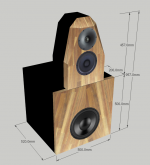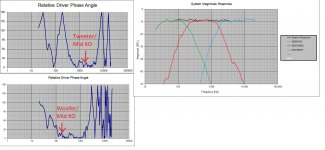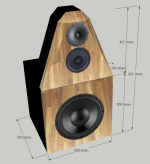I introduce The Cathedrals.
They are an all sealed, active design. They are in the concept and planning stage but comprise the following:
1 x Dayton RSS390HF-4 15" aluminium woofer
1 x SB Acoustics SB17NBAC-4 6" aluminium as a midrange
1 x SB Acoustics SB26ADC 1" aluminium dome tweeter
The SB26ADC may be waveguide loaded, if the profile of the Visaton WG148R is suitable.
Current crossover points are ~ 200hz and ~1900Hz.
What I wanted over my current 3 ways:
- Larger woofer. a 15" should move enough air.
- Lower F3. The Dayton models ~32Hz in a 124L sealed enclosure. There's enough xmax and with an active crossover I can tailor the in-room response with xmax to spare.
- Modular. I want to separate bass and mid/tweeter sections... such that I can replace mid-tweeter or have different options with the RSS390 filling in bass duties
- Wanted to try a waveguide. This may not work in practice. I have a plan B if that is the case.
- Try an active crossover. This will be using a Raspberry Pi, running ecasound LADSPA host and credit to Charlie Laub's Active Crossover Design tools to provide the ecasound filters.
- An all metal design
The relative phase graphs show the phase difference between driver pairs. I'm trying to get these <= 15 degrees at least 2 octaves either side of the XO points. More work required
They are an all sealed, active design. They are in the concept and planning stage but comprise the following:
1 x Dayton RSS390HF-4 15" aluminium woofer
1 x SB Acoustics SB17NBAC-4 6" aluminium as a midrange
1 x SB Acoustics SB26ADC 1" aluminium dome tweeter
The SB26ADC may be waveguide loaded, if the profile of the Visaton WG148R is suitable.
Current crossover points are ~ 200hz and ~1900Hz.
What I wanted over my current 3 ways:
- Larger woofer. a 15" should move enough air.
- Lower F3. The Dayton models ~32Hz in a 124L sealed enclosure. There's enough xmax and with an active crossover I can tailor the in-room response with xmax to spare.
- Modular. I want to separate bass and mid/tweeter sections... such that I can replace mid-tweeter or have different options with the RSS390 filling in bass duties
- Wanted to try a waveguide. This may not work in practice. I have a plan B if that is the case.
- Try an active crossover. This will be using a Raspberry Pi, running ecasound LADSPA host and credit to Charlie Laub's Active Crossover Design tools to provide the ecasound filters.
- An all metal design
The relative phase graphs show the phase difference between driver pairs. I'm trying to get these <= 15 degrees at least 2 octaves either side of the XO points. More work required
Attachments
"Try an active crossover. "
DSP on the RSS390HF woofer will allow you to equalize some bass room modes, and also allow you to trade some DSP low frequency boost for a smaller sealed cabinet for room integration or style.
Simulation of the RSS390HF recommends a 5.6cuft sealed box for Fsc=30Hz with a Qtc=0.7 alignment, and Fsc=33Hz with a Qtc=0.78 alignment in a 4cuft sealed box.
DSP on the RSS390HF woofer will allow you to equalize some bass room modes, and also allow you to trade some DSP low frequency boost for a smaller sealed cabinet for room integration or style.
Simulation of the RSS390HF recommends a 5.6cuft sealed box for Fsc=30Hz with a Qtc=0.7 alignment, and Fsc=33Hz with a Qtc=0.78 alignment in a 4cuft sealed box.
have you considered placing your tweeter below the mid? This will still meet 1/4 wave distance and it will provide you with some free time alignment. Most importantly it will place your mid driver at your seated ear level.
Nice, We don't see 100% sealed diy often. Why not to push the time alignment between mid & tweet more than with the wave horn ?
Is it possible to reduce the width of the bass cabinet or all have been calculated to bafle step compensation ?
Thanks for sharing 🙂
Is it possible to reduce the width of the bass cabinet or all have been calculated to bafle step compensation ?
Thanks for sharing 🙂
How apropos... I just completed a project using the SB26CAC (very similar to your SB26ADC), SB17CAC-35 (very similar to your SB17NBAC), and SB34NRX-75 12inch woofer... with active DSP crossovers, and with separate woofer cabinets.
I will be posting a new thread sometime soon to describe my project.
I will be posting a new thread sometime soon to describe my project.
"Try an active crossover. "
DSP on the RSS390HF woofer will allow you to equalize some bass room modes, and also allow you to trade some DSP low frequency boost for a smaller sealed cabinet for room integration or style.
Simulation of the RSS390HF recommends a 5.6cuft sealed box for Fsc=30Hz with a Qtc=0.7 alignment, and Fsc=33Hz with a Qtc=0.78 alignment in a 4cuft sealed box.
I presume there's inherent Q behaviour you can't DSP out. For example. I could make a 30L box for the RSS390 with a Qtc=1.22. Would the inherent Q peak cause resonance problems and increase distortion due to being underdamped that you just can't DSP away?
How apropos... I just completed a project using the SB26CAC (very similar to your SB26ADC), SB17CAC-35 (very similar to your SB17NBAC), and SB34NRX-75 12inch woofer... with active DSP crossovers, and with separate woofer cabinets.
I will be posting a new thread sometime soon to describe my project.
Looking forward to it! I was just about to go for the SB34NRX - however the woofer reached excursion with much lower power compared to the RSS390. They both dig deep though in sealed cabinets of the same size. I also like metal drivers. I don't know why - especially bass. My current Seas L26 10" have been great in that regard.
have you considered placing your tweeter below the mid? This will still meet 1/4 wave distance and it will provide you with some free time alignment. Most importantly it will place your mid driver at your seated ear level.
Yes that's true, but chamfered edges will be trickier to apply in an MT arrangement for the tweeter. Given I can apply 1st or 2nd order all pass filters to fix phase I'm not too worried about time alignment.
There might be something though for a softer presentation having the tweeter off listening axis, making the midrange the dominant on-axis source.
Nice, We don't see 100% sealed diy often. Why not to push the time alignment between mid & tweet more than with the wave horn ?
Is it possible to reduce the width of the bass cabinet or all have been calculated to bafle step compensation ?
Thanks for sharing 🙂
The distance at one wavelength is ~ 880Hz and therefore 1/4 is ~ 220Hz - still above the XO, so I think I'm ok.
The beauty is - with a test box I can just flip it over to try the different offsets and see which needs less DSP "hammering" for a smooth in room response.
When done, I'll post all the build details, including what I did to get the DSP up and running
Looks to be a great project, but I have to say I am not a fan of the look.
That's 4:1 (4 don't like, 1 do) 🙂 Thanks for the feedback.
i like the first look better more "cathedral" like i'd even go for a veneering scheme that simulated a brick look, perhaps some inlay work to emulate spires.... but i'm also the sort that would contemplate a miniature Quasimodo ringing a bell as a clipping indicator!
Just looking at your upper cross, the responses are at -30dB just 1 octave either side. I'd call that achieved.I'm trying to get these <= 15 degrees at least 2 octaves either side of the XO points. More work required
May I ask what software you used to make the plots..
i like the first look better more "cathedral" like i'd even go for a veneering scheme that simulated a brick look, perhaps some inlay work to emulate spires.... but i'm also the sort that would contemplate a miniature Quasimodo ringing a bell as a clipping indicator!
Yay, voting now 4:2!
Just looking at your upper cross, the responses are at -30dB just 1 octave either side. I'd call that achieved.
May I ask what software you used to make the plots..
Yes sure. Charlie's ACD (Active Crossover Designer). Spreadsheet tools. the Active Crossover Designer web page
I'm using the ACD-L partial tools set - as it generates the ecasound command line parameters for the filters you've specified
the 2 driver phase tracking spreadsheet is what you use to do the phase difference between driver pairs. being a 3 way, I needed 2 copies of this spreadsheet (woof-mid, mid-tweet)
aesthetics v2
If you use a directional tweeter below the mid your mid will interact with less of the baffle and your tweeter won't care one way or the other. Wider woofer cabinet will launch bass better than a narrow baffle will.
I thought diffraction ripple was more sensitive the higher in frequency... so both mid and tweeter could be equally affected - especially in the 1KHz - 3KHz of your normal "baffle size just bigger than the driver" baffles. All you are left with then is a) possible chamfer / large roundover and b) placement. The latter to smooth ripple at the potential expense of imaging (based on some feedback I've read from others using asymmetric driver placements on a baffle).
So your mid above tweeter is intended to provide smoother baffle diffraction? and reduce the Z offset between tweeter and mid if mid is on the listening axis. Any other reasons?
So your mid above tweeter is intended to provide smoother baffle diffraction? and reduce the Z offset between tweeter and mid if mid is on the listening axis. Any other reasons?
I qualified my statement by saying "if you use a directional tweeter" this means a tweeter with controlled dispersion. So if your tweeter has limited dispersion it will never "see" the baffle. Do you see what I am saying? By placing the mid driver up at the top of the baffle where it is the narrowest the mid will then sees less baffle also as the mid will have very much wider dispersion so less baffle is good as it results in less diffraction. The mid range is the single most important driver in the system and deserves the highest level of attention. Using a very wide band mid driver is one very good approach, think of a system with a wide band mid with a helper tweeter (harmonics only , over 6KHz,) and a helper woofer. As Paul W. Klipsch once said "we live in the midrange". Rounded cabinet edges need to be very large to work properly. Perhaps some good design books to read while you are at home?
Do you have a goal with this project? Is this a for fun learning experience successful or not? Or is your intention to design and build a good value loudspeaker? If so what are your performance goals? There are a lot of very fine commercial loudspeakers which are very cost effective especially if purchased used. Do you want a wide range three way which does not need a sub or is a sub intended as part of the ultimate system? Do you know if you prefer a two way or a three way? Lots of questions I know but your goals are important. Just an an example a pair of ProAc super tablets with a pair of good subs will absolutely astound you with precise stage and totally 3D holographic image but that is just one way to get the job done. You must have heard some systems which impressed you?
Do you have a goal with this project? Is this a for fun learning experience successful or not? Or is your intention to design and build a good value loudspeaker? If so what are your performance goals? There are a lot of very fine commercial loudspeakers which are very cost effective especially if purchased used. Do you want a wide range three way which does not need a sub or is a sub intended as part of the ultimate system? Do you know if you prefer a two way or a three way? Lots of questions I know but your goals are important. Just an an example a pair of ProAc super tablets with a pair of good subs will absolutely astound you with precise stage and totally 3D holographic image but that is just one way to get the job done. You must have heard some systems which impressed you?
Thanks. That makes sense. I'm learning here so starting to understand what you are saying. You're absolutely right about midrange. I am a big fan of hard membrane drivers. When I go back to paper or poly - they seem muffled. The problem is as you know hard membrane drivers have viscious breakups and lower frequency HD to avoid which if not dealt with properly leads to people claiming (correctly) fatigue, metal sound, harsh, forward etc...
My current 3 ways are metal and have wonderful detail, but the L15 is playing too high and I'm sure it's odd order HD is making itself known on certain recordings.. They sound wonderful on great recordings, but need to be more forgiving on lesser. I blame myself as the designer here and compromises I made.
I am also disappointed on the bass and want something I can tune to the room to get a flat in room response.
My goals therefore are:
1. Retain the detail
2. Get more / controlled bass
3. Fix midrange harshness
4. Fix imaging issues (I blame my asymmetric baffles moreso than XO choices)
I will certainly measure and try both MT and TM arrangements (where the top driver is listening axis aligned). Thanks for the suggestion!
My current 3 ways are metal and have wonderful detail, but the L15 is playing too high and I'm sure it's odd order HD is making itself known on certain recordings.. They sound wonderful on great recordings, but need to be more forgiving on lesser. I blame myself as the designer here and compromises I made.
I am also disappointed on the bass and want something I can tune to the room to get a flat in room response.
My goals therefore are:
1. Retain the detail
2. Get more / controlled bass
3. Fix midrange harshness
4. Fix imaging issues (I blame my asymmetric baffles moreso than XO choices)
I will certainly measure and try both MT and TM arrangements (where the top driver is listening axis aligned). Thanks for the suggestion!
Hey Steve: nothing wrong with a paper cone driver but plastics can also sound ver goos so can metal. Given a choice I gravitate to paper as paper distorts gradually and with grace and paper self damps. I would sugest that you buy a couple of decent used subs and then build a good two way or buy a good two way to use as a reference. As I mentioned the top of the line ProAc super tablet is very good has plastic cone. I can also highly recommend the Tannoy Reference XT Series mini a small paper cone with a state of the art dual concentric 3/4" tweeter driving a horn. I run a pair of these stand mounted or Skylan four post stands using a Benchmark AHB2 amplifier fed from a Tortuga LDR (light dependent resistor) volume control fed by a custom modified Sony DVD as a transport into a modified Metrum Octave DAC. When set up correctly this is an awesome sound. If you go use you can have a fabulous compact system which sounds anything but compact and that can be your reference. If you can better a set up like that substantially on your own then you will have achieved something special. A friend had top of the line ProAc super tablet (3K) then the ProAc Response DB2 (5K) then Avalon two ways (10K). The baby Tannoy stand tall. If you want more overall level you can move up in size to the XT6 but the smaller the driver the better it integrates and the small mini XT can play astounding loud but set up is critical. I believe that multiple small subs is the way to go if you want tight controlled bass with impact, this will also save you on high end expensive subs. This is only one way to do what you want. Others will share different approaches. You need to do some listening locally and get an idea of what you like and what you don't, as I said a reference system that does not change is critical for you to judge your handy work. You want to start with a very good source transport and DAC. Power cords and cables will very much factor into all of this as will stands and set up. I have owned a lot of loudspeakers ove r the decades running electrostats (Quad 57 Quad63 Acoustat(s) Dayton wright) for well over 20 years and also owned a lot of Tannoys dating as far back a a pair or 1947 Silver 12" DC then Monitor Gold 12" then HPD12" then HPD15" then a long break and a small entry level Mercury 7.2 Tannoy then a pair of Resolution XTmini and XT6. I just love the XT mini. The XT series are the finest Dc that Tannoy has ever made in almost 100 years in business. There are other good speakers these are the ones which have impressed me most. Good luck on your quest.
- Home
- Loudspeakers
- Multi-Way
- The Cathedrals


